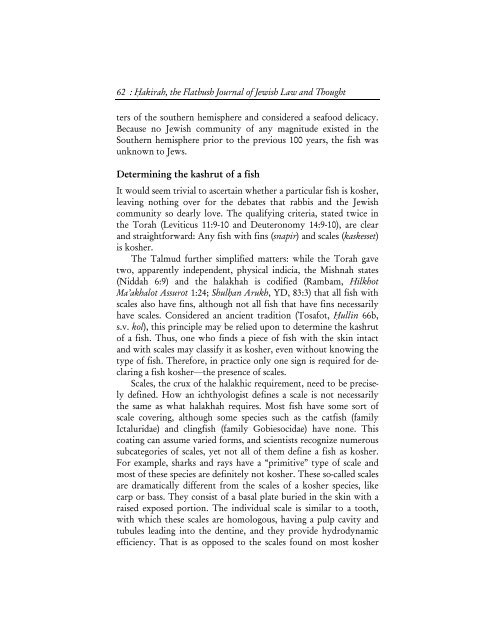The Kashrut of Kingklip: Its Turbulent History and Who ... - Hakirah
The Kashrut of Kingklip: Its Turbulent History and Who ... - Hakirah
The Kashrut of Kingklip: Its Turbulent History and Who ... - Hakirah
You also want an ePaper? Increase the reach of your titles
YUMPU automatically turns print PDFs into web optimized ePapers that Google loves.
62 : Hạkirah, the Flatbush Journal <strong>of</strong> Jewish Law <strong>and</strong> Thought<br />
ters <strong>of</strong> the southern hemisphere <strong>and</strong> considered a seafood delicacy.<br />
Because no Jewish community <strong>of</strong> any magnitude existed in the<br />
Southern hemisphere prior to the previous 100 years, the fish was<br />
unknown to Jews.<br />
Determining the kashrut <strong>of</strong> a fish<br />
It would seem trivial to ascertain whether a particular fish is kosher,<br />
leaving nothing over for the debates that rabbis <strong>and</strong> the Jewish<br />
community so dearly love. <strong>The</strong> qualifying criteria, stated twice in<br />
the Torah (Leviticus 11:9-10 <strong>and</strong> Deuteronomy 14:9-10), are clear<br />
<strong>and</strong> straightforward: Any fish with fins (snapir) <strong>and</strong> scales (kaskesset)<br />
is kosher.<br />
<strong>The</strong> Talmud further simplified matters: while the Torah gave<br />
two, apparently independent, physical indicia, the Mishnah states<br />
(Niddah 6:9) <strong>and</strong> the halakhah is codified (Rambam, Hilkhot<br />
Ma’akhalot Assurot 1:24; Shulhan Arukh, YD, 83:3) that all fish with<br />
scales also have fins, although not all fish that have fins necessarily<br />
have scales. Considered an ancient tradition (Tosafot, Hullin 66b,<br />
s.v. kol), this principle may be relied upon to determine the kashrut<br />
<strong>of</strong> a fish. Thus, one who finds a piece <strong>of</strong> fish with the skin intact<br />
<strong>and</strong> with scales may classify it as kosher, even without knowing the<br />
type <strong>of</strong> fish. <strong>The</strong>refore, in practice only one sign is required for declaring<br />
a fish kosher—the presence <strong>of</strong> scales.<br />
Scales, the crux <strong>of</strong> the halakhic requirement, need to be precisely<br />
defined. How an ichthyologist defines a scale is not necessarily<br />
the same as what halakhah requires. Most fish have some sort <strong>of</strong><br />
scale covering, although some species such as the catfish (family<br />
Ictaluridae) <strong>and</strong> clingfish (family Gobiesocidae) have none. This<br />
coating can assume varied forms, <strong>and</strong> scientists recognize numerous<br />
subcategories <strong>of</strong> scales, yet not all <strong>of</strong> them define a fish as kosher.<br />
For example, sharks <strong>and</strong> rays have a “primitive” type <strong>of</strong> scale <strong>and</strong><br />
most <strong>of</strong> these species are definitely not kosher. <strong>The</strong>se so-called scales<br />
are dramatically different from the scales <strong>of</strong> a kosher species, like<br />
carp or bass. <strong>The</strong>y consist <strong>of</strong> a basal plate buried in the skin with a<br />
raised exposed portion. <strong>The</strong> individual scale is similar to a tooth,<br />
with which these scales are homologous, having a pulp cavity <strong>and</strong><br />
tubules leading into the dentine, <strong>and</strong> they provide hydrodynamic<br />
efficiency. That is as opposed to the scales found on most kosher
















